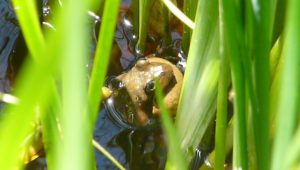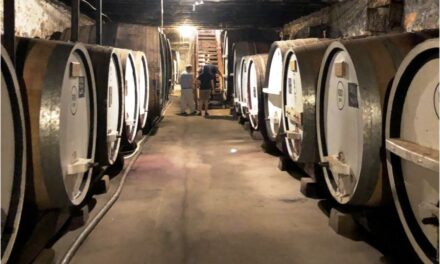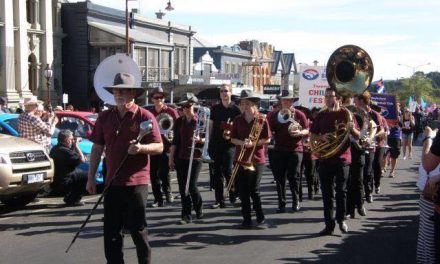Tanya Loos
Last June, we experienced a wind storm of such ferocity that large swathes of the Forest were simply flattened. Precious large old growth trees with hollows crashed to the ground, and the forest canopy was rendered unrecognisable in places such as Bullarto. I have been saying – its ok – the patches will eventually create a more patchy forest, with the open canopy allowing for growth of wattles and other midstory trees. The legacy of logging in this forest has created big areas of even aged trees, with close regrowth, and a bit of canopy opening is ok.
BUT this is on the proviso that we let the forest heal itself. We leave the soil undisturbed, we leave the logs on the ground, for habitat and for the eventually rotting wood to recycle back into the earth for a regenerating forest.
Unfortunately the opposite is happening. “Salvage” logging by VicForests is now occurring in the Wombat Forest, at the moment at Babbington Rd.
Gayle Osborne and Trevor Spiers from Wombat Forestcare have been meeting with DELWP regarding the proposed logging, trying for outcomes that are less damaging.
But VicForests, the corporate arm of the Victorian Government, is now involved, and the situation is more serious than we could have envisaged!
Gayle Osborne, from Wombat Forestcare has provided the following background.
An industrial scale salvage operation is being carried out by VicForests in the Wombat State Forest. Without any consultation, 175 coupes have been added to a new Timber Utilisation Plan, with approximately 80 within the promised Wombat-Lerderderg National Park.
VicForests has cleared well over an acre of forest to create a large machinery depot, log storage and access for B-double timber trucks. Forest tracks have been widened for machinery and truck access. This cleared area was Greater Glider and Koala habitat. (Gayle has personally spotted a Greater Glider near this coupe recently!)
The tree trunks of wind-fallen trees are being removed, leaving other debris and piles of bark. Accessing these fallen trees means that heavy machinery is bulldozing tracks and disturbing the vegetation including sedgy riparian areas.
The coupe being harvested at the moment is at the foot of the very beautiful Babbington Hill and is within the national park that the Victorian Government promised us. If this area has such important ecological values that deem it worthy of being protected as a national park then it should not be subjected to this destructive treatment.
There is concern in the community about perceived increased fire risk caused by the storm-damaged timber, however the large logs being removed are not considered the main fire risk, it is the heads of the trees and the piles of bark that are being left behind in this operation that are the biggest risk.
Careful salvage of timber and reduction of debris along roads and tracks is an important fire mitigation strategy and supported by many in the community.
The Wombat Forestcare Facebook page has a number of photos of the destructive logging at Babbington Rd.
What can we do?
Call or email politicians:
Wombat Forestcare and The Victorian National Parks Association are calling on people to contact the local member and Minister for Regional Development, Mary-Anne Thomas.
Phone: (03) 5428 2138 or Email:mary-anne.thomas@parliament.vic.gov.au
Join a Photoshoot on the site with Trentham Photographer, Sandy Schletma:
People are invited to demonstrate their concern by joining a photoshoot at 3pm on Good Friday in Babbington Road. People are encouraged to dress brightly and carry signs indicating their concern. If you attend, it is important to park cars well off the road in case the very large timber trucks are operating on Good Friday. For more information contact Gayle Osborne info@wombatforestcare.org.au
Ask Tanya
Readers are invited to submit questions for Tanya. Many readers were intrigued by Tanya’s article on our beloved pobblebonk frogs. Below, Tanya answers readers’ questions.

Pobblebonk with inflated vocal sac. (Photo: Margaret Hodge)
From Fran in Yandoit:
Hi Tania
We are new to the Yandoit area. We have a good size dam and a pond closer to the house. I often hear the pobblebonks. We are wondering if we clear our pond of carp/gold fish (we have about 24), the frogs will have a better chance of survival. We are wondering if the fish may eat the frogs eggs?
Looking forward to hearing from you and thank you for this opportunity to ask you.
Warm wishes,
Fran
Dear Fran,
Goldfish do indeed eat tadpoles. There are a few options:
1) you can modify your goldfish dam by making it safer for tadpoles – more plants to hide in, a partitioned area, reducing the number of goldfish. This article describes some options : www.bettacarefishguide.com/do-goldfish-eat-tadpoles-and-frogspawn
2) you can set up another space for frogs and tadpoles – a frog bog that has no fish or even another pond. See backyardbuddies.org.au/habitats/build-a-frog-pond/ or Costa builds a pond www.youtube.com/watch?v=i2RN7gmW3NQ
3) you can remove your goldfish but I am not sure what you would do with them! It seems sad to just kill them all. As long as you don’t release them into the waterway – they will eat tadpoles and native fish there. I have seen some amazing photos of feral goldfish attaining HUGE sizes!
I hope that helps! And welcome to the region!
Tanya
From Tim in Daylesford:
Dear Tanya,
When I hear the Pobblebonks bonking, sometimes it is a single “bonk”, sometimes it’s a “BONK bonk” and sometimes it’s a “Bonk bonk BONK”. Are multiple “bonks” from multiple frogs – a chorus of pobblebonks? Or is it a single frog getting a bit excited?
Tim.
Dear Tim,
The best way to work out whether you have multiple pobblebonks is to listen to where the bonks are coming from – if different parts of the dam – then ta daa you have many! They also do a strange kind of growl a bit like a growling grass frog.
Tanya
Tanya Loos is a local naturalist, author and environmental consultant who loves to work in the environmental not-for-profit sector. She is the author of “Daylesford Nature Diary” available from her website or from Paradise Books in Vincent Street, Daylesford.
Have you got any nature questions for Tanya? Send them in!












